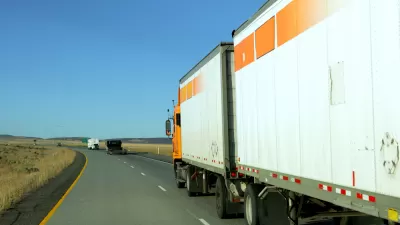The U.S. Department of Transportation proposed a new rule on Dec. 13 for automakers to require vehicle-to-vehicle technology to save lives, but critics charge the radio-based technology will be obsolete when the rule takes effect in about seven years
The proposed rule has the potential to cause traffic crashes to plummet, thus greatly reducing traffic fatalities. From the National Highway Traffic Safety Administration (NHTSA) press release:
The Notice of Proposed Rulemaking would enable vehicle-to-vehicle (V2V) communication technology on all new light-duty vehicles, enabling a multitude of new crash-avoidance applications that, once fully deployed, could prevent hundreds of thousands of crashes every year by helping vehicles “talk” to each other.
"This rule is something that has been contemplated for more than 12 years," said U.S. Transportation Secretary Anthony Foxx in announcing the mandate," writes Shiraz Ahmed of Automotive News. "From a safety perspective, this is a no-brainer."
While the goal may be a no-brainer, it turns out the choice of communication technology is by no-means settled. Ahmed reports that there are significant concerns "that technological development soon will shift away from the radio-based technology underlying NHTSA's rule -- known as dedicated short-range communication [PDF] -- making the mandate outdated by the time it takes effect."
Assuming [the rule] is adopted in 2019, all new vehicles will be fully equipped with communication technology by 2023.
But critics say the possible seven-year gap before that penetration is achieved could mean the U.S. fleet will be propping up technology that's already on its way out.
These critics support "using newer cellular technology, the kind that powers smartphone communication, instead."
The prospect of 5G cellular networks is tantalizing to vehicle connectivity experts. This year, Audi, BMW and Daimler formed an association with telecom firms Qualcomm, Huawei, Ericsson, Intel and Nokia to study the potential of 5G networks for future fleets.
We expect 5G to become the worldwide dominating mobile communications standard of the next decade," Christoph Grote, senior vice president for electronics at BMW, said in a release announcing the alliance.
However, DOT officials maintain they have chosen the right technology, and dismiss 5G as being too uncertain to implement in the near term.
Dedicated short-range communication "is the only wireless technology capable of meeting requirements," said Ken Leonard, the Transportation Department's chief of intelligent transportation systems, at an industry conference in Detroit last month. "I hear a lot of discussion that 5G is going to come, but I don't know when, whether it's '18, '20 or '25."
Leonard has the support of "industry insiders," adds Ahmed.
The technology is the "only game in town," said Gary Smith, General Motors' global r&d director. "Not to do it now, it's an opportunity that we're squandering."
Watch for the 5G vs. radio-based technology debate to intensify during the rule-making process, particularly "as the 90-day comment period on NHTSA's rule commences," notes Ahmed. Regardless of which technology is ultimately chosen, one thing is clear: the communications industry will be a winner.
Existing pilots using different communication technologies
In September 2015, Secretary Foxx announced that the new connected vehicle technology would be utilized in three pilot projects in Midtown Manhattan, Tampa, and Interstate 80 in Wyoming. Heading the program is the Transportation Department's Intelligent Transportation Systems Joint Program Office.
However, the Colorado Department of Transportation is conducting a connected vehicle pilot using existing LTE technology on Interstate 70. No additional infrastructure investment will be required by CDOT.
=========================================
Related elsewhere in media:
- hybridCARS: US Regulators Clashing With Automobile and Telecom Companies Over V2V Rules, December 26, 2016
Related in Planetizen:
-
Expect Passenger Vehicles to Talk to Each Other in the Near Future, December 18, 2016: U.S. DOT wants light-duty vehicles to communicate with each other via advanced technology, known as connected vehicle technology, to prevent crashes. The vehicle-to-vehicle (V2V) rule would be phased in over five years.
-
Vehicle-to-Vehicle and Vehicle-to-Infrastructure Tests Coming to Colorado, January 20, 2016: The Colorado Department of Transportation's RoadX pilot project will test early alerts to drivers on Interstate 70
-
White House Smart Cities Initiative Uses Connected Vehicle Technology, September 15, 2015: Secretary of Transportation Anthony Foxx unveiled a $42 million transportation program in Manhattan that is part of President Obama's new $160 million Smart Cities Initiative. Funds will go to NYC, Tampa, and Wyoming to reduce congestion and crashes.
FULL STORY: NHTSA's Vehicle-To-Vehicle Mandate Could Be DOA

Maui's Vacation Rental Debate Turns Ugly
Verbal attacks, misinformation campaigns and fistfights plague a high-stakes debate to convert thousands of vacation rentals into long-term housing.

Planetizen Federal Action Tracker
A weekly monitor of how Trump’s orders and actions are impacting planners and planning in America.

Chicago’s Ghost Rails
Just beneath the surface of the modern city lie the remnants of its expansive early 20th-century streetcar system.

Bend, Oregon Zoning Reforms Prioritize Small-Scale Housing
The city altered its zoning code to allow multi-family housing and eliminated parking mandates citywide.

Amtrak Cutting Jobs, Funding to High-Speed Rail
The agency plans to cut 10 percent of its workforce and has confirmed it will not fund new high-speed rail projects.

LA Denies Basic Services to Unhoused Residents
The city has repeatedly failed to respond to requests for trash pickup at encampment sites, and eliminated a program that provided mobile showers and toilets.
Urban Design for Planners 1: Software Tools
This six-course series explores essential urban design concepts using open source software and equips planners with the tools they need to participate fully in the urban design process.
Planning for Universal Design
Learn the tools for implementing Universal Design in planning regulations.
planning NEXT
Appalachian Highlands Housing Partners
Mpact (founded as Rail~Volution)
City of Camden Redevelopment Agency
City of Astoria
City of Portland
City of Laramie



























